Numerical Analysis of Experiments on Damage and Fracture Behavior of Differently Preloaded Aluminum Alloy Specimens
Abstract
1. Introduction
2. Continuum Damage Model
3. Experimental and Numerical Aspects
- The axis are indicated by a first subscript which can be followed by a second subscript indicating the cylinder. Both subscripts are separated by a dot, e.g., .
- Displacements are denoted by u and are measured in axis direction. The machine displacements are indicated by a superscript M, whereas the nominal displacements (measured at the red dots indicated in Figure 2e) do not have any additional superscript.
- Forces are denoted by F, and the average forces on each axis are introduced and plotted in the corresponding figures.
- The leading machine displacement of cylinder is continuously increased by mm/s.
- The same displacement is applied on the cylinder on the opposite side of the same axis as .
- The force is of the cylinder is retained at zero, which causes the machine displacement , i.e., the cylinder is force driven.
- The same displacement is applied as on the cylinder on the opposite side of the same axis.
4. Results and Discussion
4.1. Experimental Program
4.2. Preloading by , Final Loading by
4.3. Preloading by , Final Loading by
5. Conclusions
- Characterization of materials must be based on an enhanced experimental program including biaxial tests with different loading histories to analyze the stress state and stress history dependence on deformation and failure behavior.
- A sophisticated damage model must be used taking into account anisotropic and stress-state-dependent damage processes on the micro-level. The proposed continuum model based on rate equations for damage strain tensors allows simulation of deformation behavior, as well as damage and failure in structural elements undergoing various loading histories.
- Different preloading histories remarkably influence the load-displacement behavior. The specimen becomes more brittle with smaller elongations at the onset of fracture.
- The final stresses remain nearly unaffected by different preloadings, although the stress histories are different.
- Changes in the amount, width and orientation of localized strain bands occur, mainly caused by the different preloading histories.
- In shear tests, after pre-tensile-loading, regions of maximum damage move from the boundaries of the notch to its center, where onset of fracture will happen. This indicates unexpected and dangerous failure behavior.
- In shear tests, pre-tensile-loading changes the damage behavior from shear mechanisms to more void-dominated modes, indicating more brittle behavior.
- In tension tests, after pre-shear-loading, regions of maximum damage move from the center to the boundaries of the notch. Onset of the fracture process will be visible, leading to less dangerous behavior.
- In tension tests, pre-shear-loading leads to micro-shear-crack behavior, which is only marginally affected by few growing voids caused by subsequent tensile loading. The failure process will be shear-dominated.
- The experimental and numerical results may give hints and recommendations to optimize metal forming processes.
Author Contributions
Funding
Institutional Review Board Statement
Informed Consent Statement
Data Availability Statement
Acknowledgments
Conflicts of Interest
References
- Stanić, D.; Zovko Brodarac, Z.; Li, L. Influence of Copper Addition in AlSi7MgCu Alloy on Microstructure Development and Tensile Strength Improvement. Metals 2020, 10, 1623. [Google Scholar] [CrossRef]
- Yang, G.; Kim, J.K. An Overview of High Yield Strength Twinning-Induced Plasticity Steels. Metals 2021, 11, 124. [Google Scholar] [CrossRef]
- Mazlan, S.; Yidris, N.; Koloor, S.S.R.; Petrů, M. Experimental and Numerical Analysis of Fatigue Life of Aluminum Al 2024-T351 at Elevated Temperature. Metals 2020, 10, 1581. [Google Scholar] [CrossRef]
- Park, H.G.; Kang, B.S.; Kim, J. Numerical Modeling and Experimental Verification for High-Speed Forming of Al5052 with Single Current Pulse. Metals 2019, 9, 1311. [Google Scholar] [CrossRef]
- Brünig, M. A thermodynamically consistent continuum damage model taking into account the ideas of CL Chow. Int. J. Damage Mech. 2016, 25, 1130–1141. [Google Scholar] [CrossRef]
- Živković, J.; Dunić, V.; Milovanović, V.; Pavlović, A.; Živković, M. A Modified Phase-Field Damage Model for Metal Plasticity at Finite Strains: Numerical Development and Experimental Validation. Metals 2021, 11, 47. [Google Scholar] [CrossRef]
- Gerke, S.; Adulyasak, P.; Brünig, M. New biaxially loaded specimens for the analysis of damage and fracture in sheet metals. Int. J. Solids Struct. 2017, 110–111, 209–218. [Google Scholar] [CrossRef]
- Zhang, W.; Zhu, Z.; Zhou, C.; He, X. Biaxial Tensile Behavior of Commercially Pure Titanium under Various In-Plane Load Ratios and Strain Rates. Metals 2021, 11, 155. [Google Scholar] [CrossRef]
- Bai, Y.; Wierzbicki, T. A new model of metal plasticity and fracture with pressure and Lode dependence. Int. J. Plast. 2008, 24, 1071–1096. [Google Scholar] [CrossRef]
- Bonora, N.; Gentile, D.; Pirondi, A.; Newaz, G. Ductile damage evolution under triaxial state of stress: Theory and experiments. Int. J. Plast. 2005, 21, 981–1007. [Google Scholar] [CrossRef]
- Brünig, M.; Chyra, O.; Albrecht, D.; Driemeier, L.; Alves, M. A ductile damage criterion at various stress triaxialities. Int. J. Plast. 2008, 24, 1731–1755. [Google Scholar] [CrossRef]
- Driemeier, L.; Brünig, M.; Micheli, G.; Alves, M. Experiments on stress-triaxiality dependence of material behavior of aluminum alloys. Mech. Mater. 2010, 42, 207–217. [Google Scholar] [CrossRef]
- Bao, Y.; Wierzbicki, T. On fracture locus in the equivalent strain and stress triaxiality space. Int. J. Mech. Sci. 2004, 46, 81–98. [Google Scholar] [CrossRef]
- Gao, X.; Zhang, G.; Roe, C. A Study on the Effect of the Stress State on Ductile Fracture. Int. J. Damage Mech. 2010, 19, 75–94. [Google Scholar] [CrossRef]
- Li, H.; Fu, M.W.; Lu, J.; Yang, H. Ductile fracture: Experiments and computations. Int. J. Plast. 2011, 27, 147–180. [Google Scholar] [CrossRef]
- Dunand, M.; Mohr, D. On the predictive capabilities of the shear modified Gurson and the modified Mohr–Coulomb fracture models over a wide range of stress triaxialities and Lode angles. J. Mech. Phys. Solids 2011, 59, 1374–1394. [Google Scholar] [CrossRef]
- Roth, C.C.; Mohr, D. Ductile fracture experiments with locally proportional loading histories. Int. J. Plast. 2016, 79, 328–354. [Google Scholar] [CrossRef]
- Lou, Y.; Chen, L.; Clausmeyer, T.; Tekkaya, A.E.; Yoon, J.W. Modeling of ductile fracture from shear to balanced biaxial tension for sheet metals. Int. J. Solids Struct. 2017, 112, 169–184. [Google Scholar] [CrossRef]
- Liu, Y.; Kang, L.; Ge, H. Experimental and numerical study on ductile fracture of structural steels under different stress states. J. Constr. Steel Res. 2019, 158, 381–404. [Google Scholar] [CrossRef]
- Lin, S.B.; Ding, J.L. Experimental study of the plastic yielding of rolled sheet metals with the cruciform plate specimen. Int. J. Plast. 1995, 11, 583–604. [Google Scholar] [CrossRef]
- Green, D.E.; Neale, K.W.; MacEwen, S.R.; Makinde, A.; Perrin, R. Experimental investigation of the biaxial behaviour of an aluminum sheet. Int. J. Plast. 2004, 20, 1677–1706. [Google Scholar] [CrossRef]
- Kuwabara, T. Advances in experiments on metal sheets and tubes in support of constitutive modeling and forming simulations. Int. J. Plast. 2007, 23, 385–419. [Google Scholar] [CrossRef]
- Kulawinski, D.; Nagel, K.; Henkel, S.; Hübner, P.; Fischer, H.; Kuna, M.; Biermann, H. Characterization of stress–strain behavior of a cast TRIP steel under different biaxial planar load ratios. Eng. Fract. Mech. 2011, 78, 1684–1695. [Google Scholar] [CrossRef]
- Demmerle, S.; Boehler, J.P. Optimal design of biaxial tensile cruciform specimens. J. Mech. Phys. Solids 1993, 41, 143–181. [Google Scholar] [CrossRef]
- Song, X.; Leotoing, L.; Guines, D.; Ragneau, E. Characterization of forming limits at fracture with an optimized cruciform specimen: Application to DP600 steel sheets. Int. J. Mech. Sci. 2017, 126, 35–43. [Google Scholar] [CrossRef]
- Liedmann, J.; Gerke, S.; Barthold, F.J.; Brünig, M. Shape optimization of the X0-specimen: Theory, numerical simulation and experimental verification. Comput. Mech. 2020. [Google Scholar] [CrossRef]
- Brünig, M.; Brenner, D.; Gerke, S. Stress state dependence of ductile damage and fracture behavior: Experiments and numerical simulations. Eng. Fract. Mech. 2015, 141, 152–169. [Google Scholar] [CrossRef]
- Brünig, M.; Brenner, D.; Gerke, S. Modeling of Stress-State-Dependent Damage and Failure of Ductile Metals. Appl. Mech. Mater. 2015, 784, 35–42. [Google Scholar] [CrossRef]
- Wang, J.; Chow, C.L. Mixed Mode Ductile Fracture Studies With Nonproportional Loading Based on Continuum Damage Mechanics. J. Eng. Mater. Technol. 1989, 111, 204–209. [Google Scholar] [CrossRef]
- Chow, C.L.; Lu, T.J. An Analytical and Experimental Study of Mixed-Mode Ductile Fracture under Nonproportional Loading. Int. J. Damage Mech. 1992, 1, 191–236. [Google Scholar] [CrossRef]
- Cortese, L.; Nalli, F.; Rossi, M. A nonlinear model for ductile damage accumulation under multiaxial non-proportional loading conditions. Int. J. Plast. 2016, 85, 77–92. [Google Scholar] [CrossRef]
- Zhuang, X.; Wang, T.; Zhu, X.; Zhao, Z. Calibration and application of ductile fracture criterion under non-proportional loading condition. Eng. Fract. Mech. 2016, 165, 39–56. [Google Scholar] [CrossRef]
- Scales, M.; Chen, K.; Kyriakides, S. Material response, localization, and failure of an aluminum alloy under combined shear and tension: Part I experiments. Int. J. Plast. 2019, 120, 340–360. [Google Scholar] [CrossRef]
- Fincato, R.; Tsutsumi, S. Numerical modeling of the evolution of ductile damage under proportional and non-proportional loading. Int. J. Solids Struct. 2019, 160, 247–264. [Google Scholar] [CrossRef]
- Basu, S.; Benzerga, A.A. On the path-dependence of the fracture locus in ductile materials: Experiments. Int. J. Solids Struct. 2015, 71, 79–90. [Google Scholar] [CrossRef]
- Korkolis, Y.P.; Kyriakides, S. Path-dependent failure of inflated aluminum tubes. Int. J. Plast. 2009, 25, 2059–2080. [Google Scholar] [CrossRef]
- Gerke, S.; Zistl, M.; Bhardwaj, A.; Brünig, M. Experiments with the X0-specimen on the effect of non-proportional loading paths on damage and fracture mechanisms in aluminum alloys. Int. J. Solids Struct. 2019, 163, 157–169. [Google Scholar] [CrossRef]
- Brünig, M.; Zistl, M.; Gerke, S. Biaxial experiments on characterization of stress-state-dependent damage in ductile metals. Prod. Eng. 2020, 14, 87–93. [Google Scholar] [CrossRef]
- Brünig, M.; Gerke, S.; Zistl, M. Experiments and numerical simulations with the H-specimen on damage and fracture of ductile metals under non-proportional loading paths. Eng. Fract. Mech. 2019, 217, 106531. [Google Scholar] [CrossRef]
- Gerke, S.; Zistl, M.; Brünig, M. Experiments and numerical simulation of damage and fracture of the X0-specimen under non-proportional loading paths. Eng. Fract. Mech. 2020, 224, 106795. [Google Scholar] [CrossRef]
- Brünig, M. An anisotropic ductile damage model based on irreversible thermodynamics. Int. J. Plast. 2003, 19, 1679–1713. [Google Scholar] [CrossRef]
- Brünig, M.; Gerke, S.; Hagenbrock, V. Micro-mechanical studies on the effect of the stress triaxiality and the Lode parameter on ductile damage. Int. J. Plast. 2013, 50, 49–65. [Google Scholar] [CrossRef]
- Brünig, M.; Gerke, S.; Schmidt, M. Damage and failure at negative stress triaxialities: Experiments, modeling and numerical simulations. Int. J. Plast. 2018, 102, 70–82. [Google Scholar] [CrossRef]
- Brünig, M.; Gerke, S.; Hagenbrock, V. Stress-state-dependence of damage strain rate tensors caused by growth and coalescence of micro-defects. Int. J. Plast. 2014, 63, 49–63. [Google Scholar] [CrossRef]
- Brünig, M.; Hagenbrock, V.; Gerke, S. Macroscopic damage laws based on analysis of microscopic unit cells. ZAMM J. Appl. Math. Mech./Z. Angew. Math. Mech. 2018, 98, 181–194. [Google Scholar] [CrossRef]
- Voce, E. A practical strain-hardening function. Metallurgia 1955, 51, 219–226. [Google Scholar]
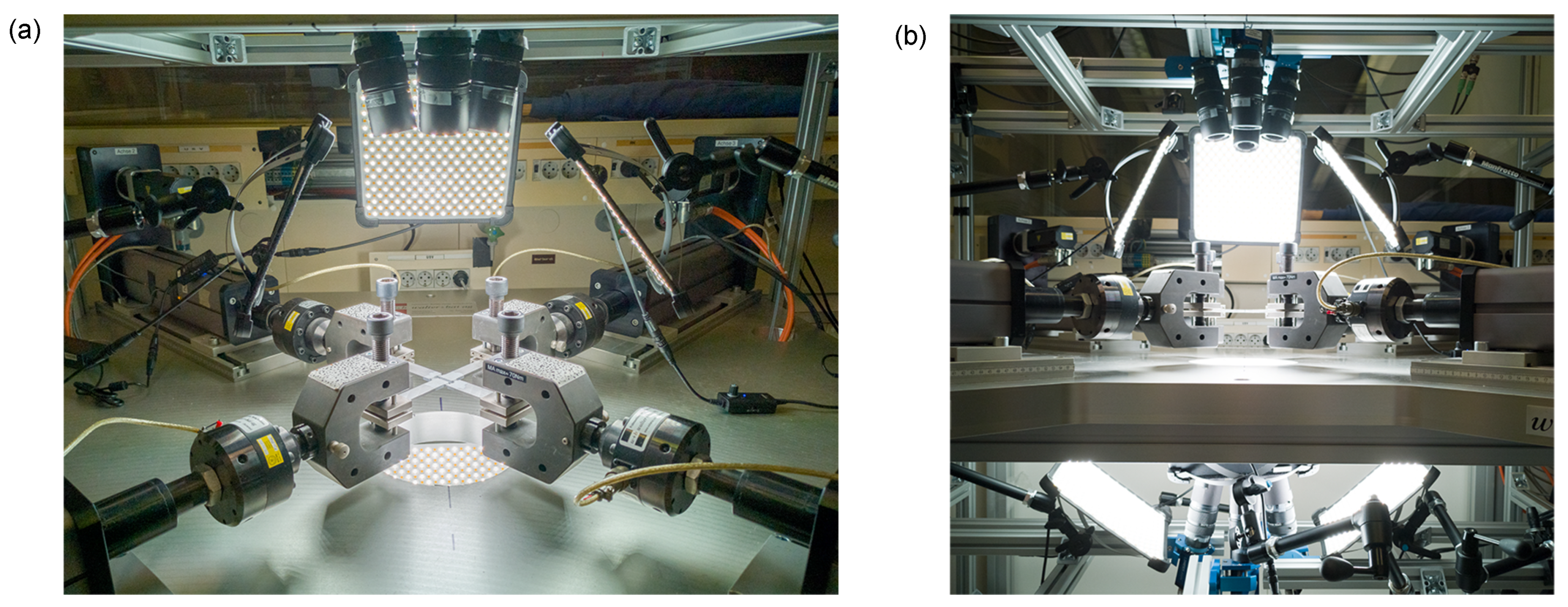
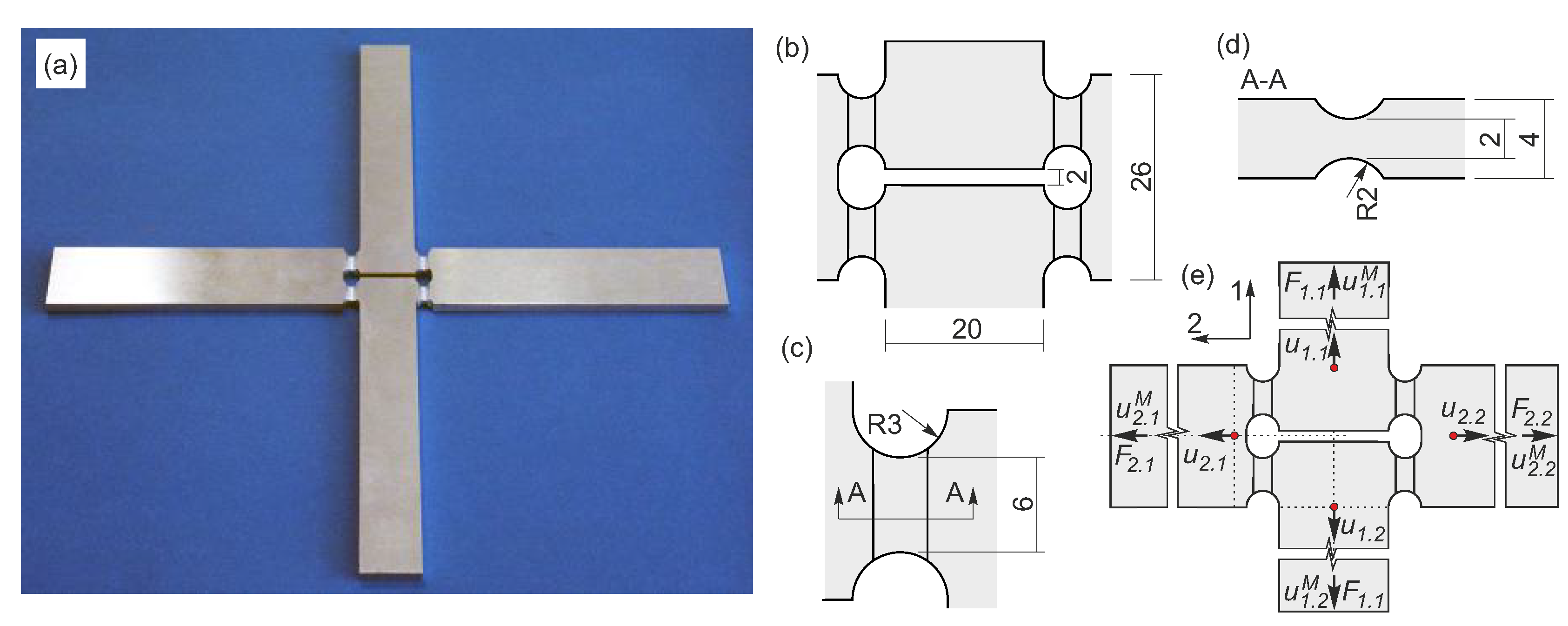

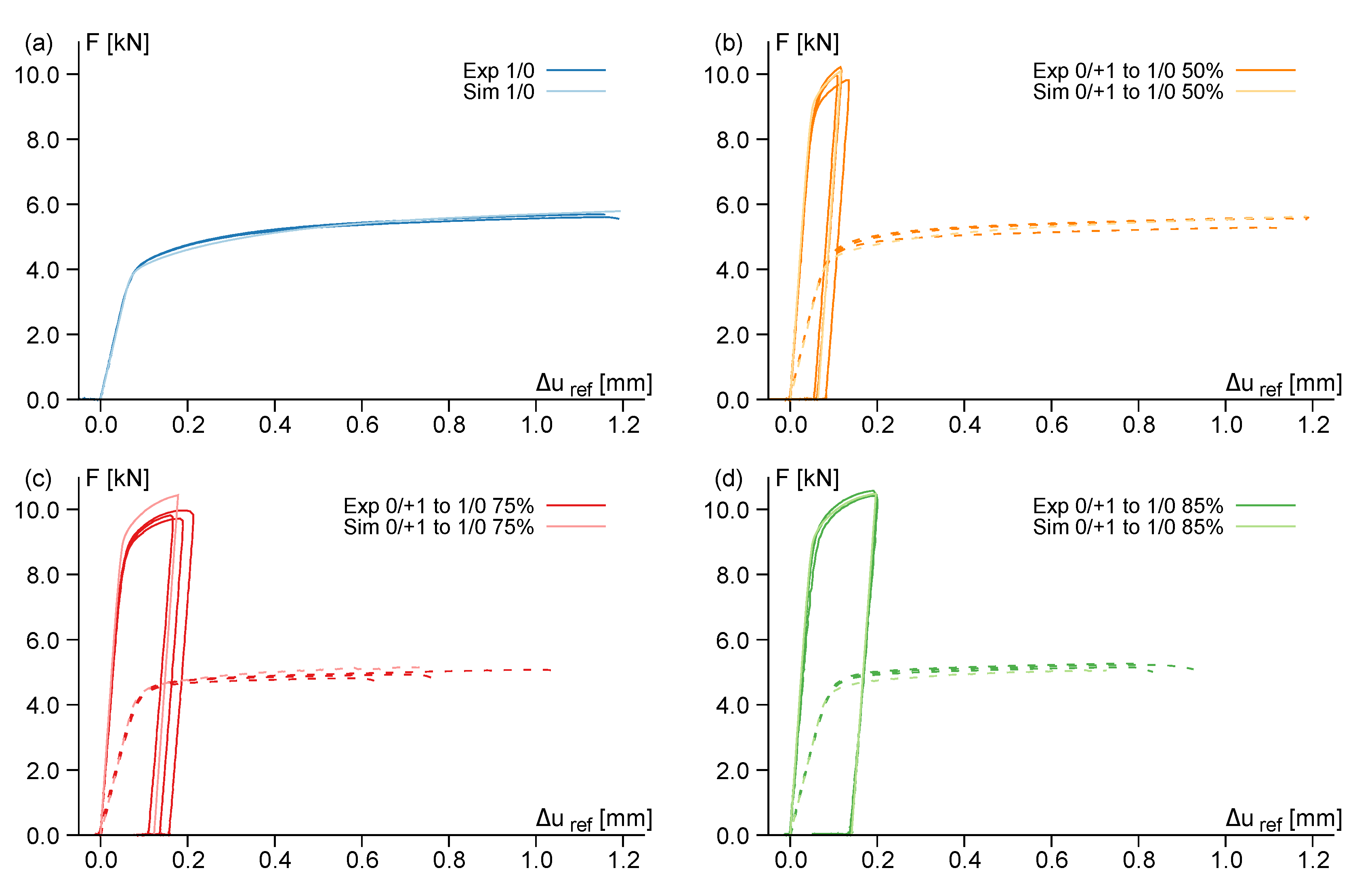
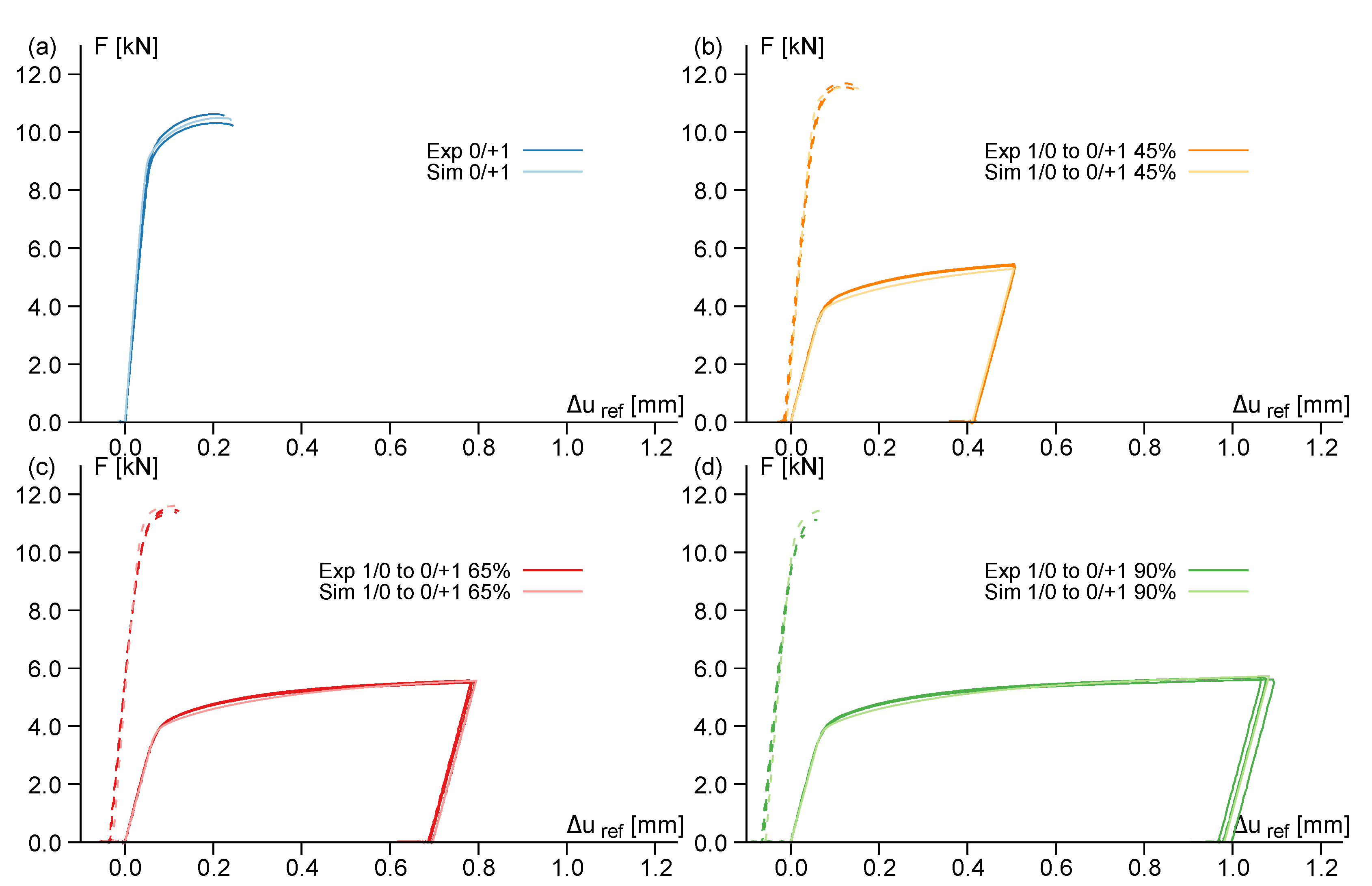
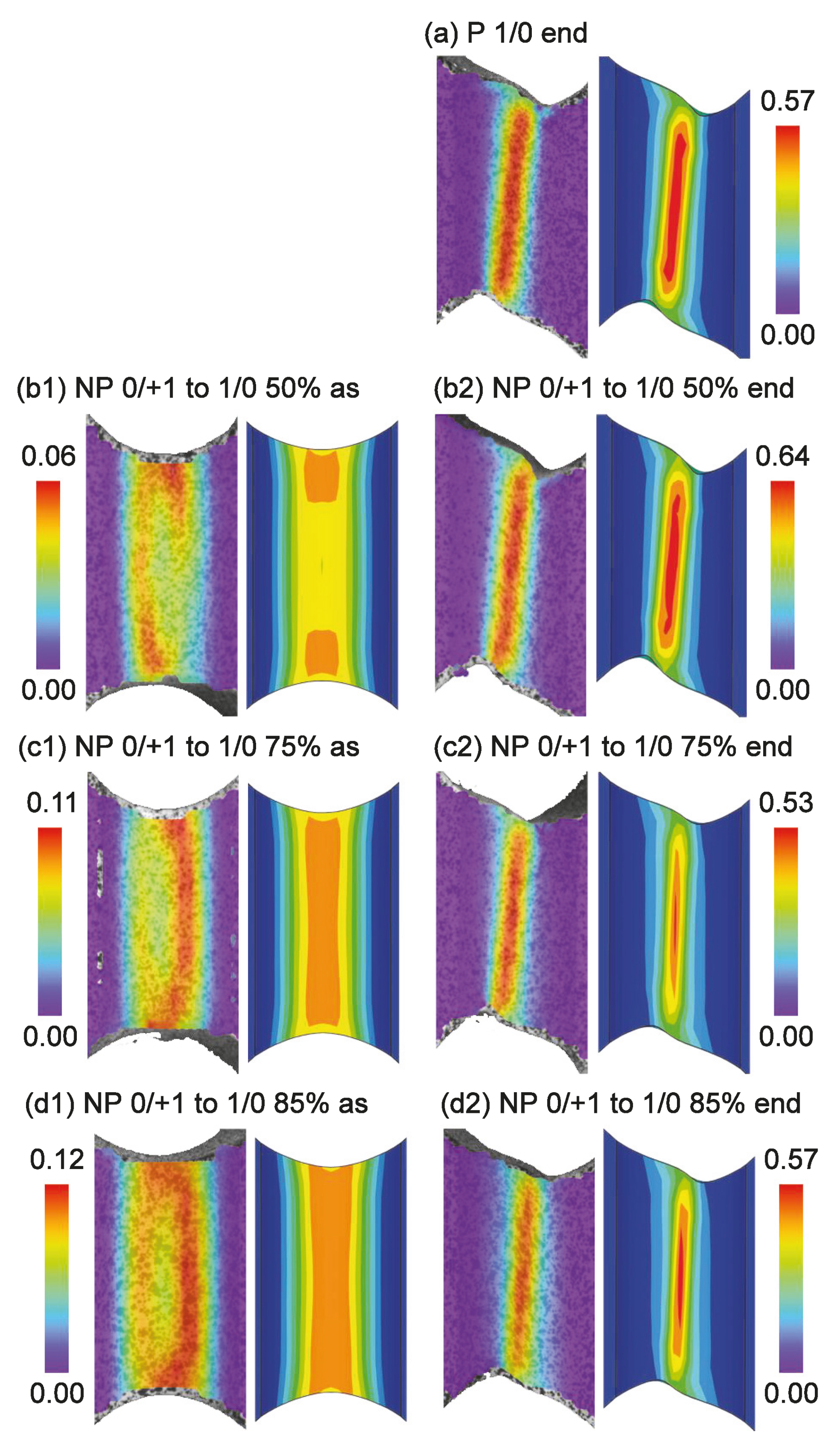
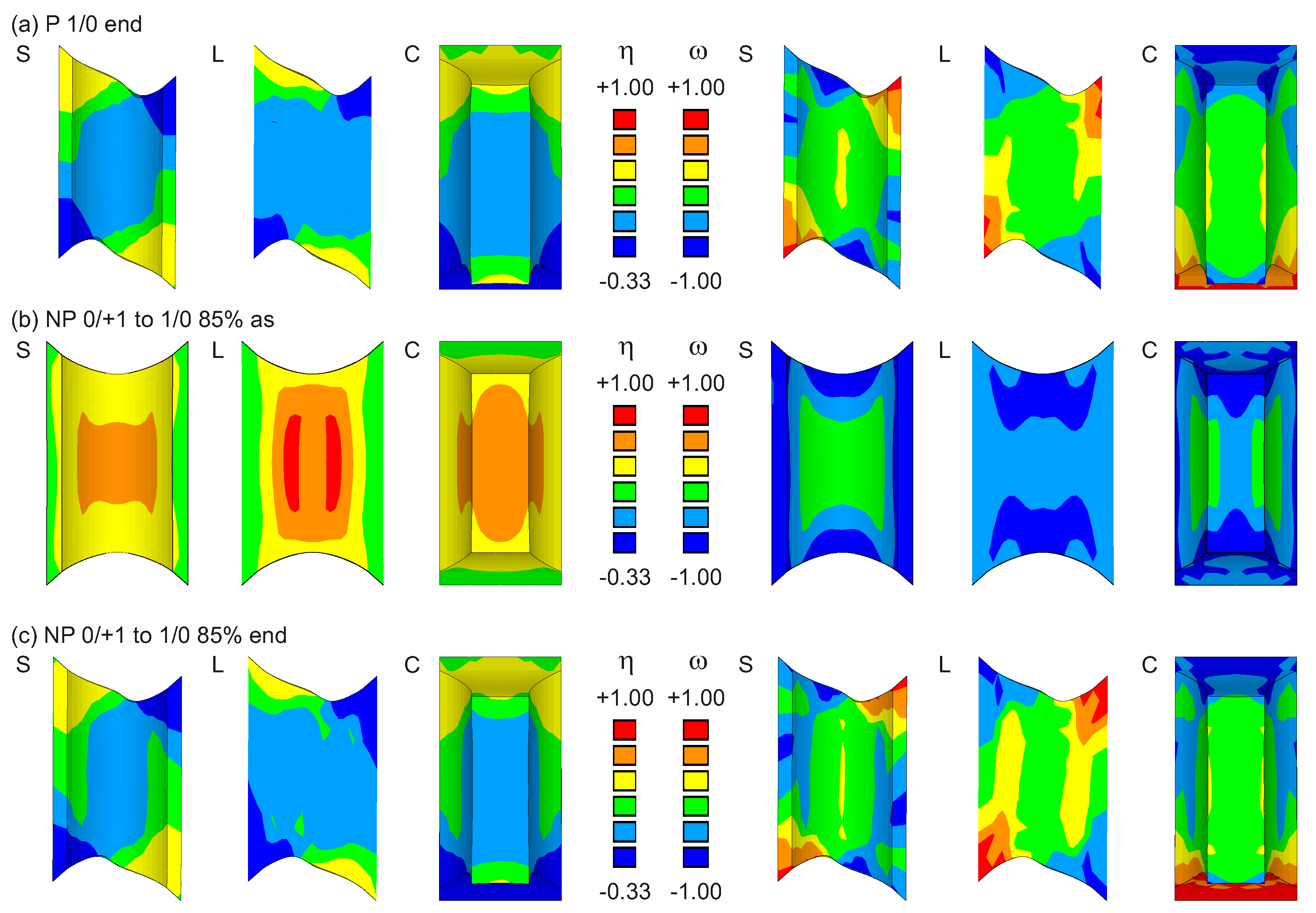
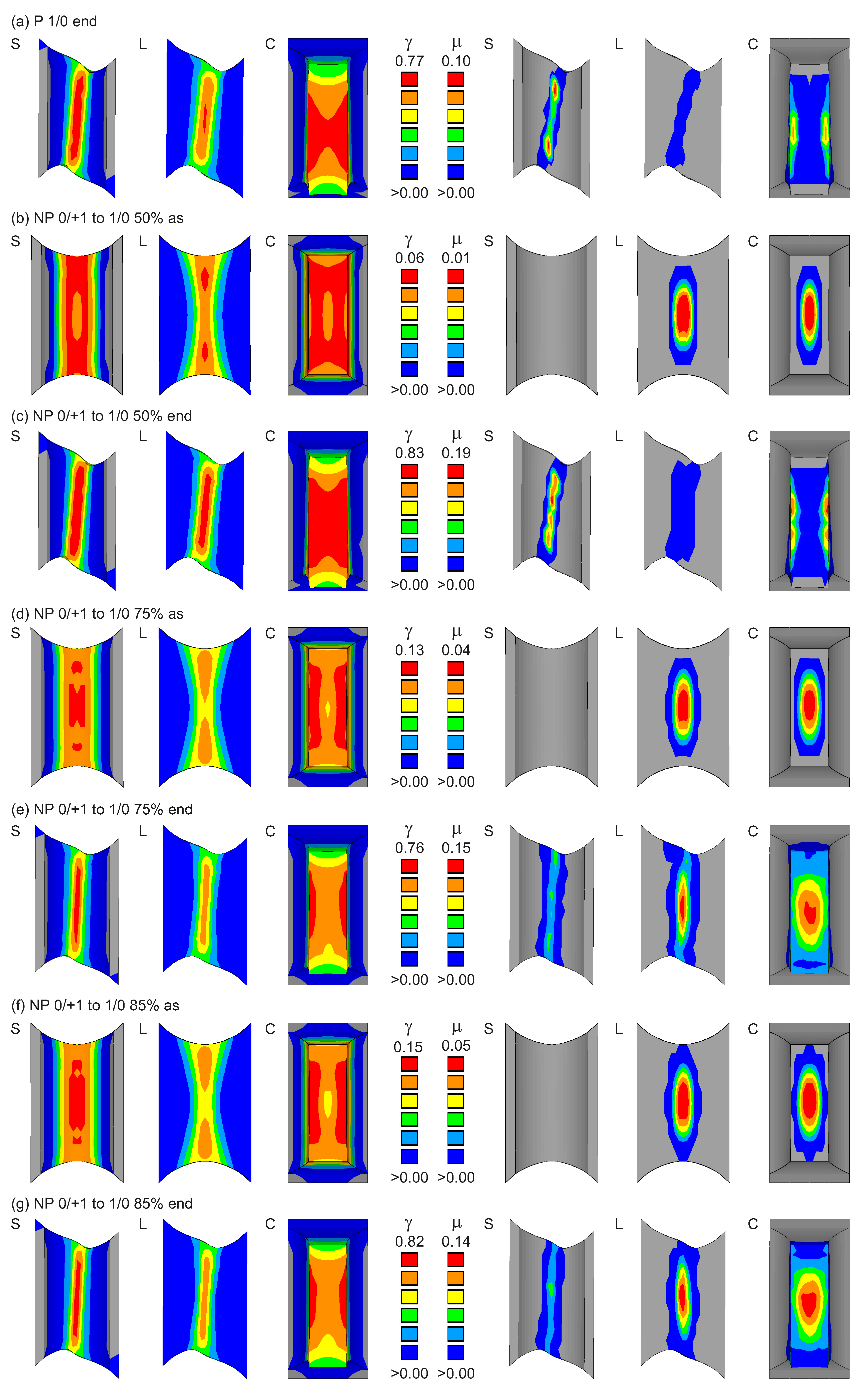

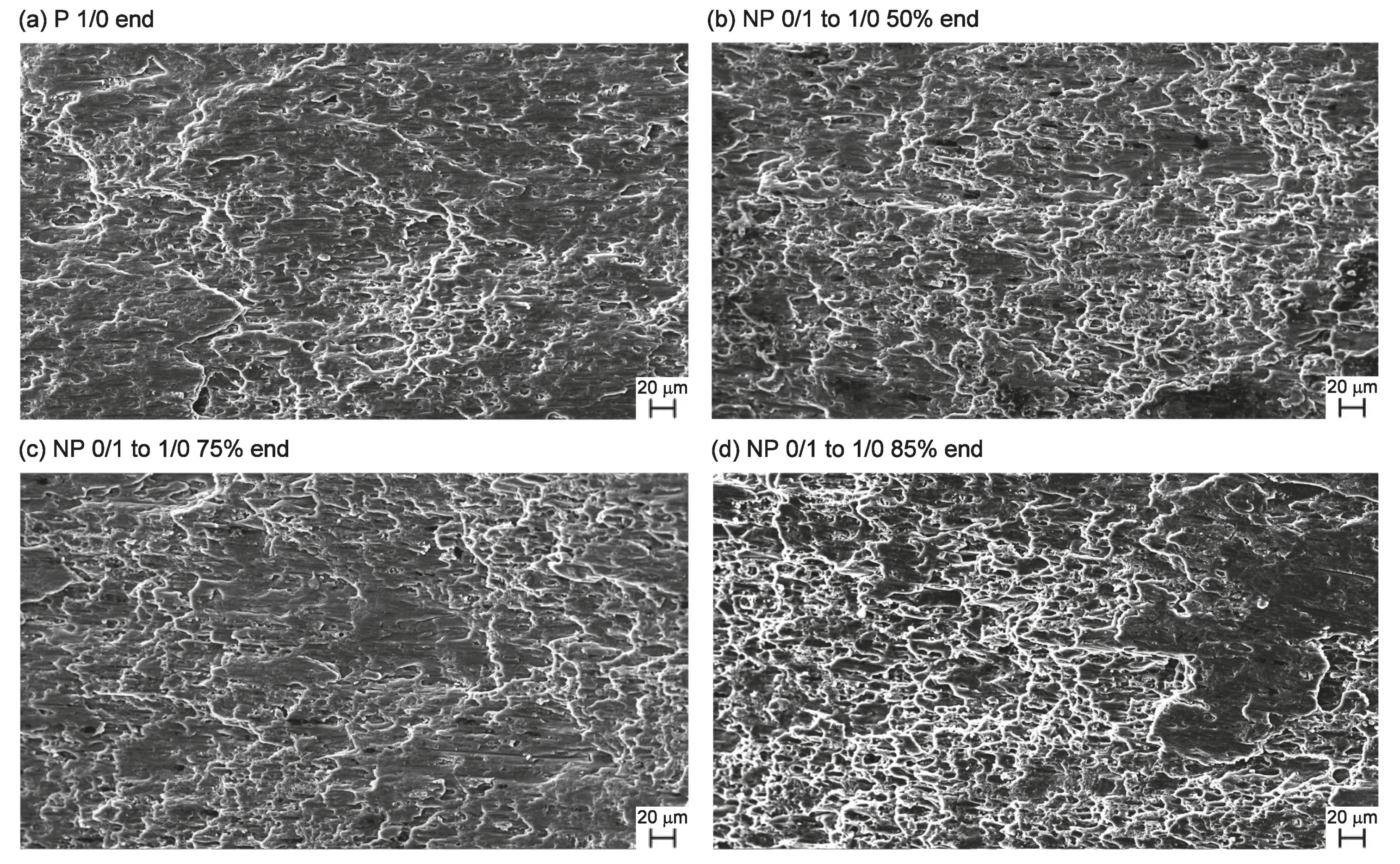
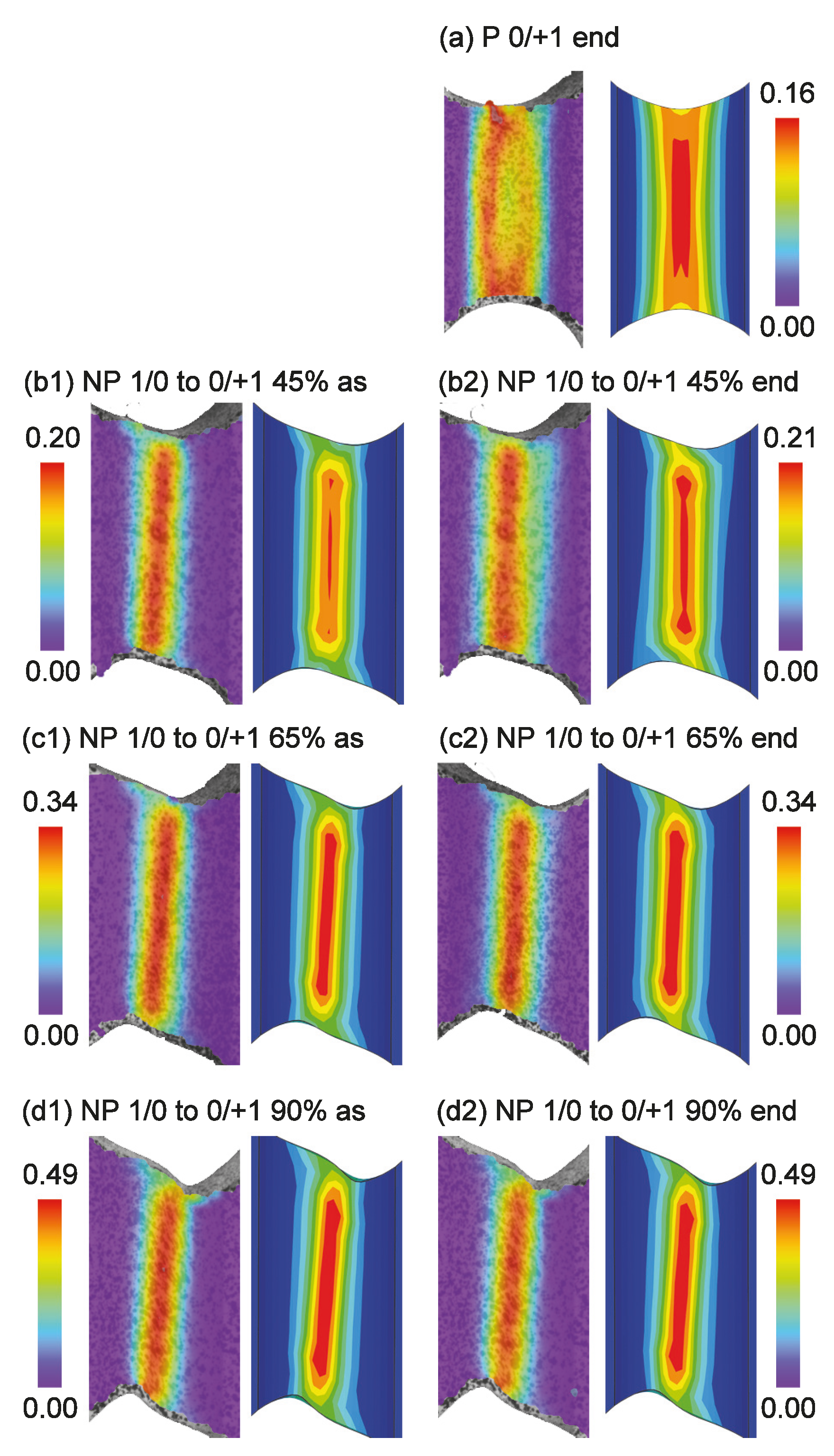



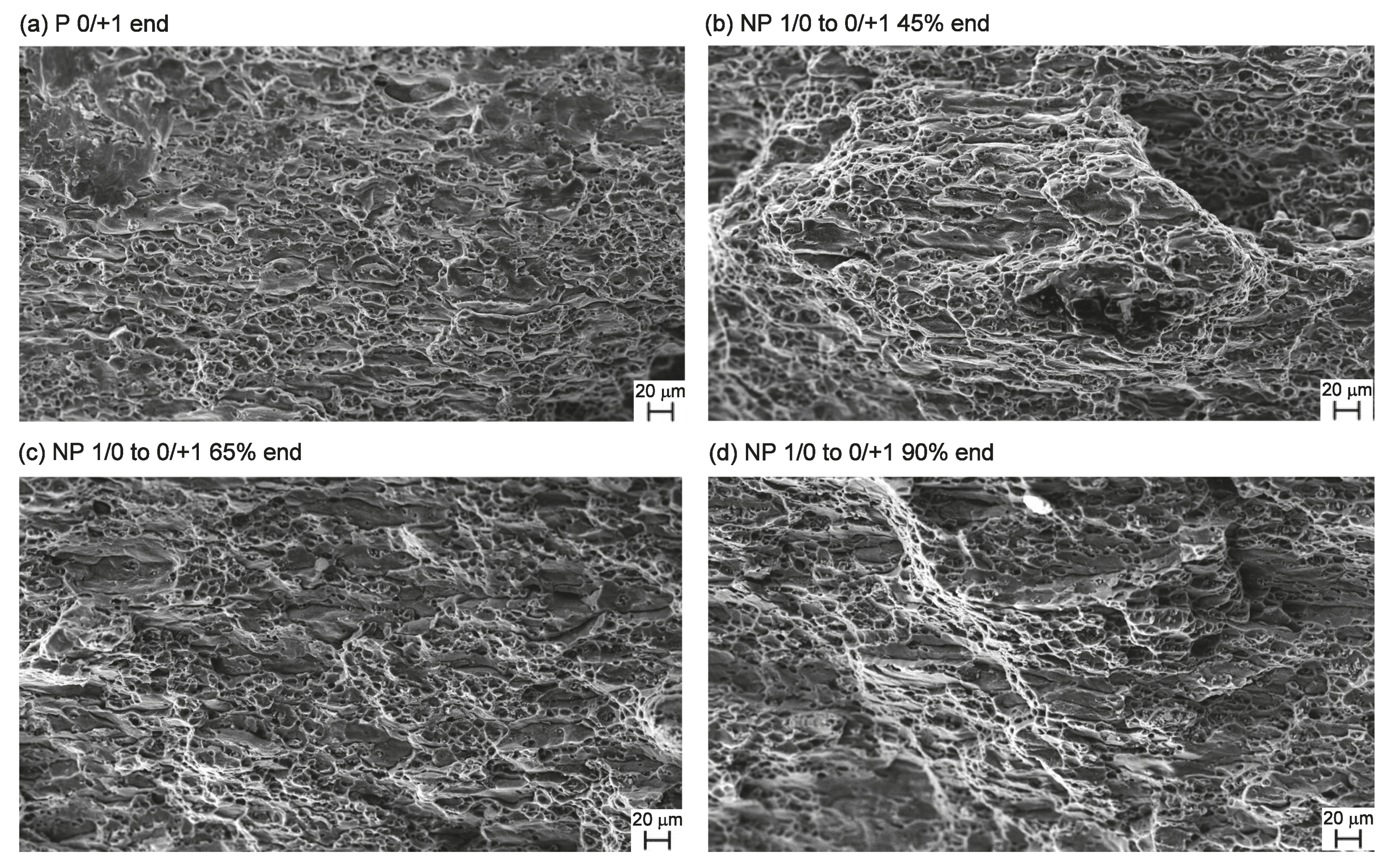
| Material | Si | Fe | Cu | Mn | Mg | Cr | Zn | Ti | Others | Al |
|---|---|---|---|---|---|---|---|---|---|---|
| EN AW 6082-T6 | 0.9 | 0.37 | 0.09 | 0.47 | 0.7 | 0.02 | 0.09 | 0.03 | 0.04 | to balance |
Publisher’s Note: MDPI stays neutral with regard to jurisdictional claims in published maps and institutional affiliations. |
© 2021 by the authors. Licensee MDPI, Basel, Switzerland. This article is an open access article distributed under the terms and conditions of the Creative Commons Attribution (CC BY) license (http://creativecommons.org/licenses/by/4.0/).
Share and Cite
Brünig, M.; Zistl, M.; Gerke, S. Numerical Analysis of Experiments on Damage and Fracture Behavior of Differently Preloaded Aluminum Alloy Specimens. Metals 2021, 11, 381. https://doi.org/10.3390/met11030381
Brünig M, Zistl M, Gerke S. Numerical Analysis of Experiments on Damage and Fracture Behavior of Differently Preloaded Aluminum Alloy Specimens. Metals. 2021; 11(3):381. https://doi.org/10.3390/met11030381
Chicago/Turabian StyleBrünig, Michael, Moritz Zistl, and Steffen Gerke. 2021. "Numerical Analysis of Experiments on Damage and Fracture Behavior of Differently Preloaded Aluminum Alloy Specimens" Metals 11, no. 3: 381. https://doi.org/10.3390/met11030381
APA StyleBrünig, M., Zistl, M., & Gerke, S. (2021). Numerical Analysis of Experiments on Damage and Fracture Behavior of Differently Preloaded Aluminum Alloy Specimens. Metals, 11(3), 381. https://doi.org/10.3390/met11030381







